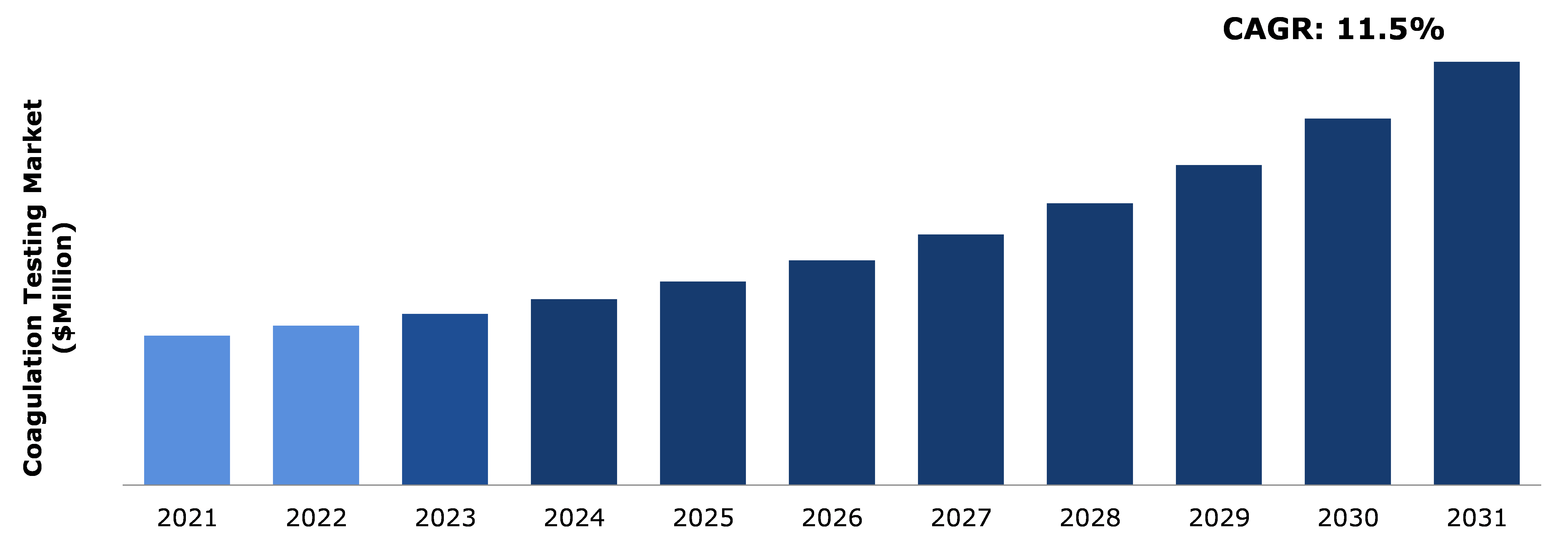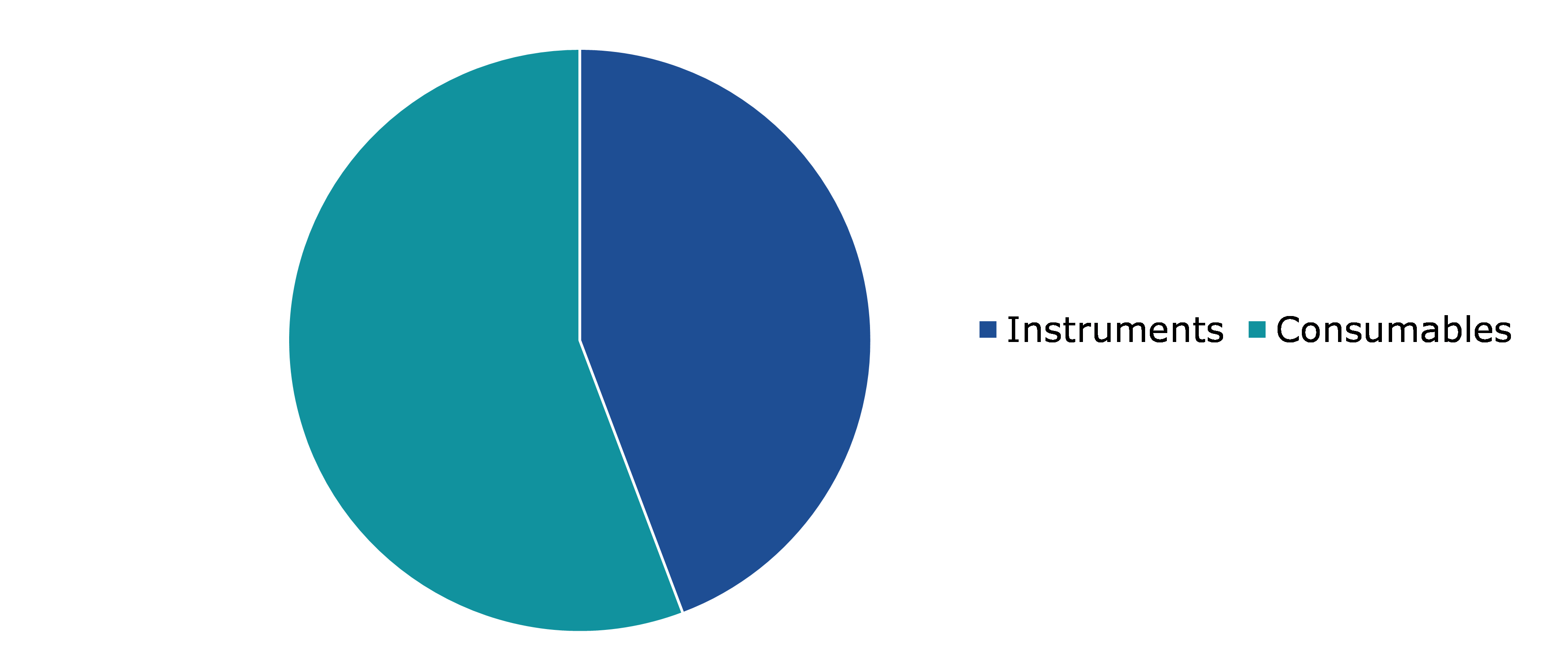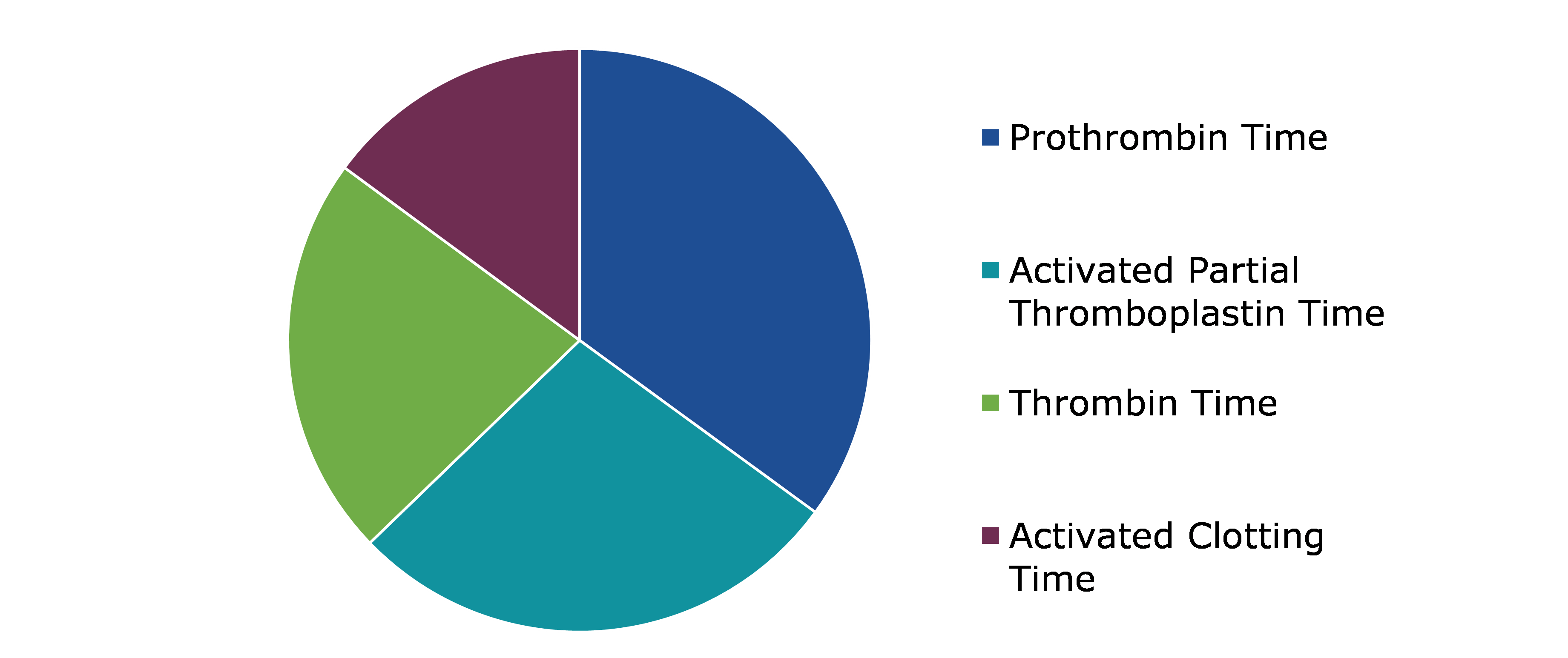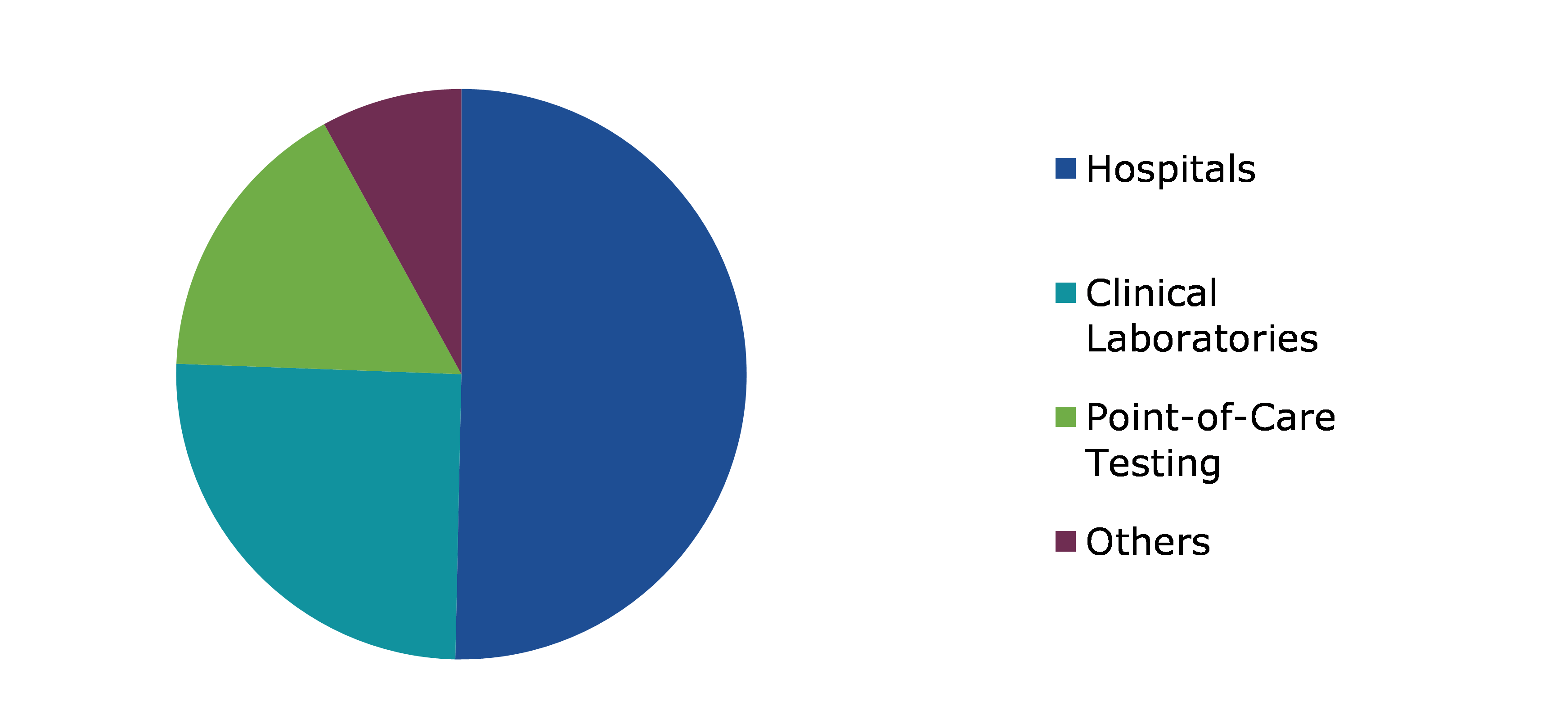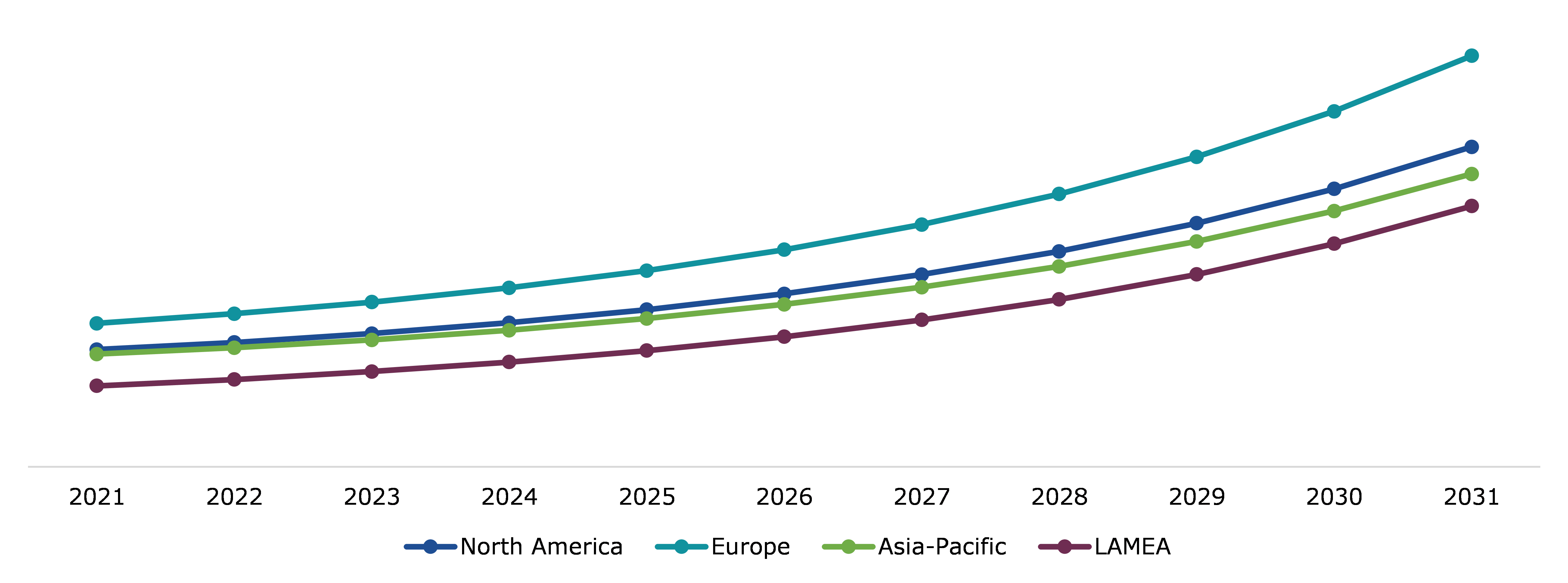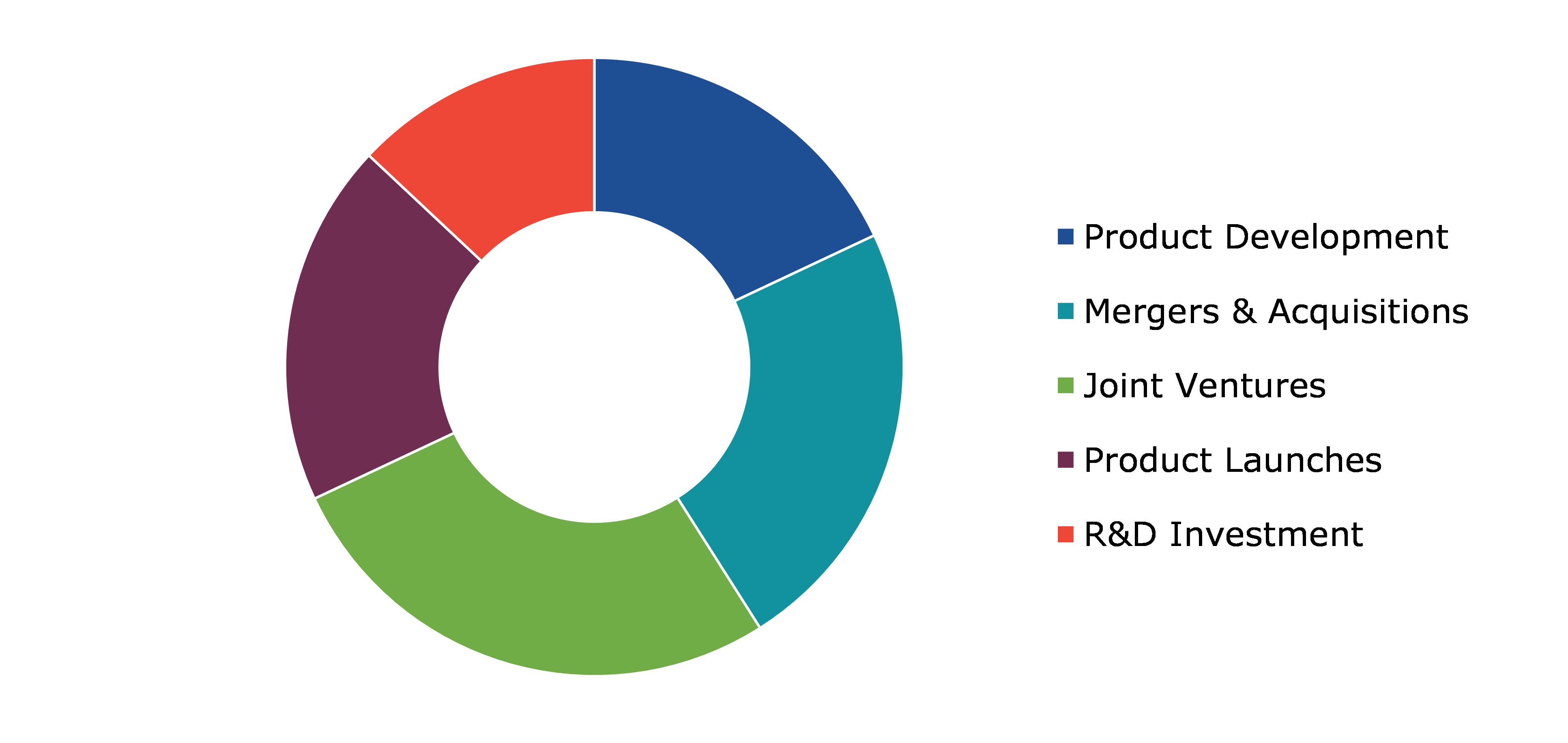Coagulation Testing Market Report
RA00086
Coagulation Testing Market by Product Type (Instruments, Consumables), Application (Prothrombin Time, Activated Partial Thromboplastin Time, Thrombin Time, Activated Clotting Time), End User (Hospitals, Clinical Laboratories, Point-of-Care Testing, Others), and Regional Analysis (North America, Europe, Asia-Pacific, and LAMEA): Global Opportunity Analysis and Industry Forecast, 2022-2031
Global Coagulation Testing Market Analysis
The global coagulation testing market size was $3,101,7 million in 2021 and is predicted to grow with a CAGR of 11.5%, by generating a revenue of $8,777.3 million by 2031.
Coagulation Testing Market Synopsis
The demand for specialized hematology and coagulation laboratories is projected to drive the coagulation testing market growth. Modern technologies, including fluorescence microscopy, microfluidics, electrochemical sensing, and photoacoustic detection, are used to construct point-of-care (POC) devices. POC tools are used to measure blood clotting's optical, mechanical, and electrochemical components. These technical developments are anticipated to expedite the market expansion for coagulation testing. In addition, it is projected that rising cardiovascular issues and chronic blood illnesses will promote global coagulation testing market size in the upcoming years. For instance, a study by the World Health Organization (WHO) has stated that cardiovascular diseases (CVDs) account for about 31% of all patient mortality each year
The global markets for coagulation testing have been negatively impacted by strict government regulations, high costs, and risks connected with tests and treatments, which restrict their use globally. The coagulation testing market share is also hindered by a shortage of competent workers and increased device costs. Numerous studies have concluded that point-of-care coagulation testing (POCCT) findings are less trustworthy than test results from central laboratories, which further calls into question the business viability of these devices.
It is projected that the smartphone-based blood coagulation test will propel the coagulation testing market opportunity in the upcoming years. This self-testing technique uses a device to monitor blood flow in people taking anticoagulant medication. Because of the device, patients may perform this test at home. Prothrombin time (PT) and activated partial thromboplastin time (APTT), two crucial coagulation markers, can be evaluated on this platform. These devices are very effective and dependable. These factors are anticipated to boost the coagulation testing market share in the upcoming years.
Coagulation Testing Market Overview
Blood coagulation, also known as clotting process, is a change in the blood's physical characteristics brought on by the transformation of the plasma protein fibrinogen, which is soluble, into fibrin, a solid gel. Coagulation tests are mainly performed by a coagulometer, which analyzes the ability of the blood to clot and the blood clotting time. These tests reduce the chances of heart attack, thrombosis, and embolism by detecting the presence of blood clots in blood vessels.
COVID-19 Impact on Global Coagulation Testing Market
The COVID-19 outbreak continues to cause worldwide havoc, and scientists are extremely concerned about developing antidotes for the new coronavirus that has been infecting people since the end of last year. Research teams and scientific researchers are exploring numerous ways to develop medical treatments to combat COVID-19 extensively around the world. The COVID-19 outbreak is holding the door open for collaboration and coordination, so trauma intensive care physicians and attendants can use their resources and apply them in the critical care setting to deal with new problems. Patients with COVID-19 are being screened for blood clotting abnormalities such as COVID-19-associated coagulopathy.
The most common pattern of blood coagulation observed in patients suffering from COVID-19 is identified by elevations in fibrinogen and D-dimer levels. This leads to the identification of a parallel increase in signs of inflammation. Since COVID-19 primarily affects the respiratory system, which is responsible for the continuous purification and oxygenation of the blood, the diagnosis of COVID-19 leads to subsequent blood coagulation tests. In addition, many of government organizations are implementing several steps to enable the companies to persist amid the coronavirus crisis. Furthermore, the government has planned to boost innovations in areas including telemedicine, life science, pharmaceutical, and healthcare industries. These factors are anticipated to boost the coagulation testing market growth in the upcoming years.
Massively growing cases of chronic blood diseases are expected to drive the global coagulation testing market
The market for coagulation testing is expected to increase as a result of the rising need for specialized hematology and coagulation laboratories. Point-of-care (POC) devices are created using cutting-edge technologies such as fluorescence microscopy, microfluidics, electrochemical sensing, and photoacoustic detection. POC instruments primarily gauge the optical, mechanical, and electrochemical aspects of blood clotting. It is projected that these technological advancements will accelerate the coagulation testing market size in the upcoming years. In addition, it is anticipated that chronic blood diseases and widely increasing cardiovascular problems will encourage global coagulation testing market growth. For instance, according to research by the World Health Organization (WHO), around 31% of all patient fatalities each year are caused by cardiovascular disorders (CVDs).
Higher cost of coagulation devices and lack of professionals is anticipated to restrain the growth of global coagulation testing industry
Due to stringent government regulations and the high risk and costs associated with tests and treatments, which limit their usage to only the population that is economically capable, have a negative impact on the global coagulation testing market. Lack of skilled labor and higher cost of devices may affect the global market growth. Several studies have declared that the test results at the central laboratories are more reliable than the tests by the Point of Care Coagulation Testing (POCCT) devices, which further debates their attractiveness in the market.
Recent inventions such as smartphone-enabled coagulation tests are projected to create enormous opportunities for the coagulation testing industry
It is projected that the smartphone-based blood coagulation test will propel market expansion. This self-testing method uses an instrument to track blood flow in individuals receiving anticoagulant medication. Due to the device, patients can perform this test at home. On this platform, it is possible to assess the prothrombin time (PT) and activated partial thromboplastin time (APTT), two important coagulation indicators. These systems are incredibly dependable and efficient. These market trends for coagulation testing may present vast chances for the industry's growth.
Global Coagulation Testing Market, by Type
Based on type, the market has been divided into instruments and consumables. Among these, the consumables sub-segment accounted for the highest market share, whereas the instruments sub-segment is estimated to show the fastest growth during the forecast period.
Global Coagulation Testing Market Outlook, by Type, 2021
Source: Research Dive Analysis
The consumables sub-segment has accounted for the highest share in the market. The growing popularity of kits and reagents is a primary driver to boost the growth of the consumables segment in the upcoming years. For instance, an increase in the usage of coagulation analyzers in cardiovascular diseases and other blood-related disorders is estimated to boost the growth of this sub-segment during the analysis timeframe.
The instruments sub-segment is the fastest-growing sub-segment in the market. Significant developments have also been accomplished in the capabilities and flexibility of coagulation instrumentation, as analyzers in labs and hospitals must run around the clock to produce timely and accurate findings. Current technologies now offer a complete walkaway environment in which, when specimens and reagents are loaded and the testing procedure is started, the operator can go on to accomplish other duties. The newest POC coagulation analyzers give rapid findings without abandoning the diagnostic quality controls supplied by the central lab. These factors are anticipated to propel the demand for instruments in the coagulation testing market.
Global Coagulation Testing Market, by Application
Based on application, the market has been divided into prothrombin time, activated partial thromboplastin time, thrombin time, and activated clotting time. Among these, the prothrombin time sub-segment accounted for the highest revenue share.
Global Coagulation Testing Market Growth, by Application, 2021
Source: Research Dive Analysis
The prothrombin time sub-segment emerged as the highest revenue-generating segment in the market. Clotting time tests such as prothrombin time are often conducted in an outpatient or hospital environment for the assessment of the hemostatic system. Newly designed prothrombin time testing instruments are combined with sensor technologies that are quicker and more user-friendly. Also, the growing adoption of prothrombin time (PT) tests across clinical laboratories, hospitals, and other healthcare centers is anticipated to propel its demand and popularity.
The activated clotting time sub-segment is anticipated to show the fastest growth during the forecast period. Activated partial thromboplastin time (APTT) is also known as the partial thromboplastin time (PTT) test, which is widely used to detect the amount of time required for the formation of the blood clot. The activated partial thromboplastin time or PTT test is used for detecting the function of specific coagulation factors for the identification of any bleeding disorders such as hemophilia. Also, this test can effectively help in the detection of excessive bleeding or clotting problems in autoimmune diseases. Activated partial thromboplastin time (APTT) test is performed on kaolin- or ellagic acid-activated plasma that can indicate intrinsic clotting.
Global Coagulation Testing Market, by End User
Based on end user, the market has been divided into hospitals, clinical laboratories, point-of-care testing, and others. Among these, the point-of-care testing sub-segment rapidly progressing during the forecast period.
Global Coagulation Testing Market Share, by End User, 2021
Source: Research Dive Analysis
The hospitals sub-segment has accounted for a dominant market size in 2021 and is anticipated to maintain its dominance in the global market during the forecast period. The hospital is an essential part of a social and medical institution. Its mission is to provide the public with comprehensive health care in both curative and preventive ways. So, people are turning to hospitals and health facilities for routine blood testing as they become more aware of the risks of cardiovascular disease, obesity, and hypertension.
The point-of-care testing sub-segment is anticipated to show the fastest growth during the forecast period. Point-of-care coagulation testing (POCCT) allows clinicians to quickly assess a patient's coagulation status in real-time. POCCT has various advantages over standard coagulation assays. The rise in demand for hospitals, as well as an increase in competition among therapists and suppliers, are likely to boost global market expansion. Furthermore, clinicians are assessing emerging technology and ensuring that patients benefit from new developments in coagulation testing. POCT for perioperative coagulation offers sophisticated interactions within the clotting system, reduces turnaround test times, and reduces incorrect transfusion.
Global Coagulation Testing Market, Regional Insights
The coagulation testing market was investigated across North America, Europe, Asia-Pacific, and LAMEA.
Global Coagulation Testing Market Size & Forecast, by Region, 2021-2031 (USD Million)
Source: Research Dive Analysis
The Market for Coagulation Testing in Europe Accounted for Highest Market Size in 2021
Europe coagulation testing market accounted for the highest market size in 2021. The growing incidence of cardiovascular diseases such as strokes, heart attacks, and expansion of hospitals and healthcare centers is anticipated to boost the Europe coagulation testing market growth during the forecast period. Sekisui and Abbott have partnered to supply coagulation diagnostic solutions to laboratories worldwide. Blood clotting tests examine a person's capacity to clot bleeding, which might assist clinicians to determine the risks of severe bleeding or clot formation.
The Market for Coagulation Testing in Asia-Pacific to Show Significant Growth
The Asia-Pacific coagulation testing market is anticipated to show a significant growth rate during the forecast period. The Asia-Pacific coagulant testing market is being driven by the aging population, an increase in the prevalence of chronic diseases such as immune disorders and cardiovascular diseases, the development of point-of-care (POC) coagulation testing, and a rise in laboratory automation. Several people are using blood clotting testers owing to the increase in bleeding and other illnesses linked to modern lifestyles.
Competitive Scenario in the Global Coagulation Testing Market
Partnerships, business expansion, and acquisitions are some of the common strategies followed by major market players in the coagulation testing market. Businesses are seeking to increase their market competitiveness by investing in the development of innovative, more efficient products that are also environmentally friendly. In 2019, Nihon Kohden established a hematology analyzer reagent factory in Dubai.
Source: Research Dive Analysis
Some of the significant coagulation testing market players include Thermo Fisher Scientific Inc., Helena Laboratories Corporation., Micropoint Biosciences, Medtronic, F. Hoffmann-La Roche Ltd, Nihon Kohden Corporation., Abbott., Sysmex Corporation, BD., and Danaher.
| Aspect | Particulars |
| Historical Market Estimations | 2020 |
| Base Year for Market Estimation | 2021 |
| Forecast Timeline for Market Projection | 2022-2031 |
| Geographical Scope | North America, Europe, Asia-Pacific, LAMEA |
| Segmentation by Product Type |
|
| Segmentation by Application |
|
| Segmentation by End-Use |
|
| Key Companies Profiled |
|
Q1. What is the size of the global Coagulation Testing market?
A. The global coagulation testing market size was over $3,101.7 million in 2021, and is projected to reach $8,777.3 million by 2031.
Q2. Which are the major companies in the Coagulation Testing market?
A. Abbott, BD, and Danaher are some of the key players in the global coagulation testing market.
Q3. Which region, among others, possesses greater investment opportunities in the near future?
A. The Europe region possesses great investment opportunities for investors to witness the most promising growth in the future.
Q4. What will be the growth rate of the Europe Coagulation Testing market?
A. Europe coagulation testing market is anticipated to grow at 11.6% CAGR during the forecast period.
Q5. What are the strategies opted for by the leading players in this market?
A. Business expansion, partnership, and acquisition are the key strategies adopted by the operating companies in this market.
Q6. Which companies are investing more on R&D practices?
A. Thermo Fisher Scientific Inc. and Medtronic companies are investing more on R&D activities for developing new products and technologies.
1.Research Methodology
1.1.Desk Research
1.2.Real time insights and validation
1.3.Forecast model
1.4.Assumptions and forecast parameters
1.5.Market size estimation
1.5.1.Top-down approach
1.5.2.Bottom-up approach
2.Report Scope
2.1.Market definition
2.2.Key objectives of the study
2.3.Report overview
2.4.Market segmentation
2.5.Overview of the impact of COVID-19 on Global Coagulation Testing Market
3.Executive Summary
4.Market Overview
4.1.Introduction
4.2.Growth impact forces
4.2.1.Drivers
4.2.2.Restraints
4.2.3.Opportunities
4.3.Market value chain analysis
4.3.1.List of component suppliers
4.3.2.List of manufacturers
4.3.3.List of distributors
4.4.Innovation & sustainability matrices
4.4.1.Technology matrix
4.4.2.Regulatory matrix
4.5.Porter’s five forces analysis
4.5.1.Bargaining power of suppliers
4.5.2.Bargaining power of consumers
4.5.3.Threat of substitutes
4.5.4.Threat of new entrants
4.5.5.Competitive rivalry intensity
4.6.PESTLE analysis
4.6.1.Political
4.6.2.Economical
4.6.3.Social
4.6.4.Technological
4.6.5.Environmental
4.7.Impact of COVID-19 on Coagulation Testing Market
4.7.1.Pre-covid market scenario
4.7.2.Post-covid market scenario
5.Coagulation Testing Market Analysis, by Product
5.1.Overview
5.2.Instruments
5.2.1.Definition, key trends, growth factors, and opportunities, 2022-2031
5.2.2.Market size analysis, by region, 2022-2031
5.2.3.Market share analysis, by country, 2022-2031
5.3.Consumables
5.3.1.Definition, key trends, growth factors, and opportunities, 2022-2031
5.3.2.Market size analysis, by region, 2022-2031
5.3.3.Market share analysis, by country, 2022-2031
5.4.Research Dive Exclusive Insights
5.4.1.Market attractiveness
5.4.2.Competition heatmap
6.Coagulation Testing Market Analysis, by Application
6.1.Prothrombin Time
6.1.1.Definition, key trends, growth factors, and opportunities, 2022-2031
6.1.2.Market size analysis, by region, 2022-2031
6.1.3.Market share analysis, by country, 2022-2031
6.2.Activated Partial Thromboplastin Time
6.2.1.Definition, key trends, growth factors, and opportunities, 2022-2031
6.2.2.Market size analysis, by region, 2022-2031
6.2.3.Market share analysis, by country, 2022-2031
6.3.Thrombin Time
6.3.1.Definition, key trends, growth factors, and opportunities, 2022-2031
6.3.2.Market size analysis, by region, 2022-2031
6.3.3.Market share analysis, by country, 2022-2031
6.4.Activated Clotting Time
6.4.1.Definition, key trends, growth factors, and opportunities, 2022-2031
6.4.2.Market size analysis, by region, 2022-2031
6.4.3.Market share analysis, by country, 2022-2031
6.5.Research Dive Exclusive Insights
6.5.1.Market attractiveness
6.5.2.Competition heatmap
7.Coagulation Testing Market Analysis, by End User
7.1.Hospitals
7.1.1.Definition, key trends, growth factors, and opportunities, 2022-2031
7.1.2.Market size analysis, by region, 2022-2031
7.1.3.Market share analysis, by country, 2022-2031
7.2.Clinical Laboratories
7.2.1.Definition, key trends, growth factors, and opportunities, 2022-2031
7.2.2.Market size analysis, by region, 2022-2031
7.2.3.Market share analysis, by country, 2022-2031
7.3.Point-of-Care Testing
7.3.1.Definition, key trends, growth factors, and opportunities, 2022-2031
7.3.2.Market size analysis, by region, 2022-2031
7.3.3.Market share analysis, by country, 2022-2031
7.4.Others
7.4.1.Definition, key trends, growth factors, and opportunities, 2022-2031
7.4.2.Market size analysis, by region, 2022-2031
7.4.3.Market share analysis, by country, 2022-2031
7.5.Research Dive Exclusive Insights
7.5.1.Market attractiveness
7.5.2.Competition heatmap
8.Coagulation Testing Market, by Region
8.1.North America
8.1.1.U.S.
8.1.1.1.Market size analysis, by Product, 2022-2031
8.1.1.2.Market size analysis, by Application, 2022-2031
8.1.1.3.Market size analysis, by End User, 2022-2031
8.1.2.Canada
8.1.2.1.Market size analysis, by Product, 2022-2031
8.1.2.2.Market size analysis, by Application, 2022-2031
8.1.2.3.Market size analysis, by End User, 2022-2031
8.1.3.Mexico
8.1.3.1.Market size analysis, by Product, 2022-2031
8.1.3.2.Market size analysis, by Application, 2022-2031
8.1.3.3.Market size analysis, by End User, 2022-2031
8.1.4.Research Dive Exclusive Insights
8.1.4.1.Market attractiveness
8.1.4.2.Competition heatmap
8.2.Europe
8.2.1.Germany
8.2.1.1.Market size analysis, by Product, 2022-2031
8.2.1.2.Market size analysis, by Application, 2022-2031
8.2.1.3.Market size analysis, by End User, 2022-2031
8.2.2.UK
8.2.2.1.Market size analysis, by Product, 2022-2031
8.2.2.2.Market size analysis, by Application, 2022-2031
8.2.2.3.Market size analysis, by End User, 2022-2031
8.2.3.France
8.2.3.1.Market size analysis, by Product, 2022-2031
8.2.3.2.Market size analysis, by Application, 2022-2031
8.2.3.3.Market size analysis, by End User, 2022-2031
8.2.4.Spain
8.2.4.1.Market size analysis, by Product, 2022-2031
8.2.4.2.Market size analysis, by Application, 2022-2031
8.2.4.3.Market size analysis, by End User, 2022-2031
8.2.5.Italy
8.2.5.1.Market size analysis, by Product, 2022-2031
8.2.5.2.Market size analysis, by Application, 2022-2031
8.2.5.3.Market size analysis, by End User, 2022-2031
8.2.6.Rest of Europe
8.2.6.1.Market size analysis, by Product, 2022-2031
8.2.6.2.Market size analysis, by Application, 2022-2031
8.2.6.3.Market size analysis, by End User, 2022-2031
8.2.7.Research Dive Exclusive Insights
8.2.7.1.Market attractiveness
8.2.7.2.Competition heatmap
8.3.Asia-Pacific
8.3.1.China
8.3.1.1.Market size analysis, by Product, 2022-2031
8.3.1.2.Market size analysis, by Application, 2022-2031
8.3.1.3.Market size analysis, by End User, 2022-2031
8.3.2.Japan
8.3.2.1.Market size analysis, by Product, 2022-2031
8.3.2.2.Market size analysis, by Application, 2022-2031
8.3.2.3.Market size analysis, by End User, 2022-2031
8.3.3.India
8.3.3.1.Market size analysis, by Product, 2022-2031
8.3.3.2.Market size analysis, by Application, 2022-2031
8.3.3.3.Market size analysis, by End User, 2022-2031
8.3.4.Australia
8.3.4.1.Market size analysis, by Product, 2022-2031
8.3.4.2.Market size analysis, by Application, 2022-2031
8.3.4.3.Market size analysis, by End User, 2022-2031
8.3.5.South Korea
8.3.5.1.Market size analysis, by Product, 2022-2031
8.3.5.2.Market size analysis, by Application, 2022-2031
8.3.5.3.Market size analysis, by End User, 2022-2031
8.3.6.Rest of Asia-Pacific
8.3.6.1.Market size analysis, by Product, 2022-2031
8.3.6.2.Market size analysis, by Application, 2022-2031
8.3.6.3.Market size analysis, by End User, 2022-2031
8.3.7.Research Dive Exclusive Insights
8.3.7.1.Market attractiveness
8.3.7.2.Competition heatmap
8.4.LAMEA
8.4.1.Brazil
8.4.1.1.Market size analysis, by Product, 2022-2031
8.4.1.2.Market size analysis, by Application, 2022-2031
8.4.1.3.Market size analysis, by End User, 2022-2031
8.4.2.Saudi Arabia
8.4.2.1.Market size analysis, by Product, 2022-2031
8.4.2.2.Market size analysis, by Application, 2022-2031
8.4.2.3.Market size analysis, by End User, 2022-2031
8.4.3.UAE
8.4.3.1.Market size analysis, by Product, 2022-2031
8.4.3.2.Market size analysis, by Application, 2022-2031
8.4.3.3.Market size analysis, by End User, 2022-2031
8.4.4.South Africa
8.4.4.1.Market size analysis, by Product, 2022-2031
8.4.4.2.Market size analysis, by Application, 2022-2031
8.4.4.3.Market size analysis, by End User, 2022-2031
8.4.5.Rest of LAMEA
8.4.5.1.Market size analysis, by Product, 2022-2031
8.4.5.2.Market size analysis, by Application, 2022-2031
8.4.5.3.Market size analysis, by End User, 2022-2031
8.4.6.Research Dive Exclusive Insights
8.4.6.1.Market attractiveness
8.4.6.2.Competition heatmap
9.Competitive Landscape
9.1.Top winning strategies, 2021
9.1.1.By strategy
9.1.2.By year
9.2.Strategic overview
9.3.Market share analysis, 2021
10.Company Profiles
10.1. Thermo Fisher Scientific Inc.
10.1.1.Overview
10.1.2.Business segments
10.1.3.Product portfolio
10.1.4.Financial performance
10.1.5.Recent developments
10.1.6.SWOT analysis
10.2.Helena Laboratories Corporation.
10.2.1.Overview
10.2.2.Business segments
10.2.3.Product portfolio
10.2.4.Financial performance
10.2.5.Recent developments
10.2.6.SWOT analysis
10.3.Micropoint Biosciences
10.3.1.Overview
10.3.2.Business segments
10.3.3.Product portfolio
10.3.4.Financial performance
10.3.5.Recent developments
10.3.6.SWOT analysis
10.4.Medtronic
10.4.1.Overview
10.4.2.Business segments
10.4.3.Product portfolio
10.4.4.Financial performance
10.4.5.Recent developments
10.4.6.SWOT analysis
10.5.Hoffmann-La Roche Ltd
10.5.1.Overview
10.5.2.Business segments
10.5.3.Product portfolio
10.5.4.Financial performance
10.5.5.Recent developments
10.5.6.SWOT analysis
10.6.NIHON KOHDEN CORPORATION
10.6.1.Overview
10.6.2.Business segments
10.6.3.Product portfolio
10.6.4.Financial performance
10.6.5.Recent developments
10.6.6.SWOT analysis
10.7.Sysmex Corporation
10.7.1.Overview
10.7.2.Business segments
10.7.3.Product portfolio
10.7.4.Financial performance
10.7.5.Recent developments
10.7.6.SWOT analysis
10.8.Abbott
10.8.1.Overview
10.8.2.Business segments
10.8.3.Product portfolio
10.8.4.Financial performance
10.8.5.Recent developments
10.8.6.SWOT analysis
10.9.BD Biosciences
10.9.1.Overview
10.9.2.Business segments
10.9.3.Product portfolio
10.9.4.Financial performance
10.9.5.Recent developments
10.9.6.SWOT analysis
10.10.Danaher
10.10.1.Overview
10.10.2.Business segments
10.10.3.Product portfolio
10.10.4.Financial performance
10.10.5.Recent developments
10.10.6.SWOT analysis
Blood coagulation testing is a medical procedure done to measure the ability of blood to clot and the time required for blood clotting. Blood clotting simply refers to the thickening of the blood gushing out of a wound from liquid to solid state. Hemostasis, which causes blood clotting, thus helps in preventing excessive blood loss due to injuries. Blood coagulation testing is done prior to almost every major surgery, as surgeries involve cutting or tearing some part of the body to perform certain medical procedures. Hence, coagulation tests are done before surgeries for having an idea about the blood clotting ability of the patient’s blood.
Forecast Analysis of the Global Market
A growing demand for specialized hematology and coagulation laboratories is predicted to help the coagulation testing market to register a huge growth in the 2022-2031 timeframe. Along with this, technological advancements including fluorescence microscopy, microfluidics, electrochemical sensing, etc. are expected to boost the market further. Furthermore, the increasing prevalence of chronic blood diseases is predicted to offer numerous growth opportunities to the market in the analysis timeframe. However, high cost of coagulation devices may hamper the growth of the coagulation testing market in the estimated timeframe.
Regionally, the coagulation testing market in the Europe region is expected to be the most profitable in the forecast period. The growing incidence of cardiovascular diseases such as strokes, heart attacks, etc., is expected to be the primary growth driver of the market in this region.
As per a report by Research Dive, the global coagulation testing market is expected to reach a revenue of $8,777.3 million in the 2021–2031 timeframe, thereby growing at a stunning CAGR of 11.5% by 2031. Some prominent market players include Thermo Fisher Scientific Inc., F. Hoffmann-La Roche Ltd, Sysmex Corporation, Helena Laboratories Corporation, Nihon Kohden Corporation., BD., Micropoint Biosciences, Abbott, Danaher, Micropoint Biosciences, and many others.
Covid-19 Impact on the Coagulation Testing Market
The Covid-19 pandemic and the subsequent lockdowns have had a catastrophic impact on various businesses and markets worldwide. The coagulation testing market, however, has been an exception. Since there has been an overall increase in demand for blood coagulation tests during the pandemic years, the market registered high growth during these years and is expected to continue on this growth trajectory in the coming period.
Significant Market Developments
The key players of the market are adopting various business strategies such as partnerships, mergers & acquisitions, and launches to gain a leading position in the market, thus helping the coagulation testing market to flourish. For instance:
- In April 2020, Haemonetics Corporation, a healthcare company, announced that it was acquiring Enicor, a German blood coagulation test system manufacturing company. The acquisition is predicted to boost the market share of the acquiring company in the coming period.
- In July 2020, Sysmex Europe GmbH, a laboratory equipment supplier, launched two blood coagulation testing analyzers, the CN-6000 and CN-3000. These products help the patients to swiftly diagnose the blood coagulation ability of their blood sample. Many medical experts consider the launch of these two products to be a pathbreaking step in the blood coagulation testing methodologies.
- In October 2021, Trivitron Healthcare, a leading medical device manufacturing company, announced that it was partnering with Diagon- Vanguard Diagnostics, a diagnostics healthcare company. This partnership is aimed at launching Diagon's coagulation analyzers in the market which is anticipated to help both companies to increase their foothold in the industry in the coming years.
Personalize this research
- Triangulate with your own data
- Request your format and definition
- Get a deeper dive on a specific application, geography, customer or competitor
- + 1-888-961-4454 Toll - Free
- support@researchdive.com

